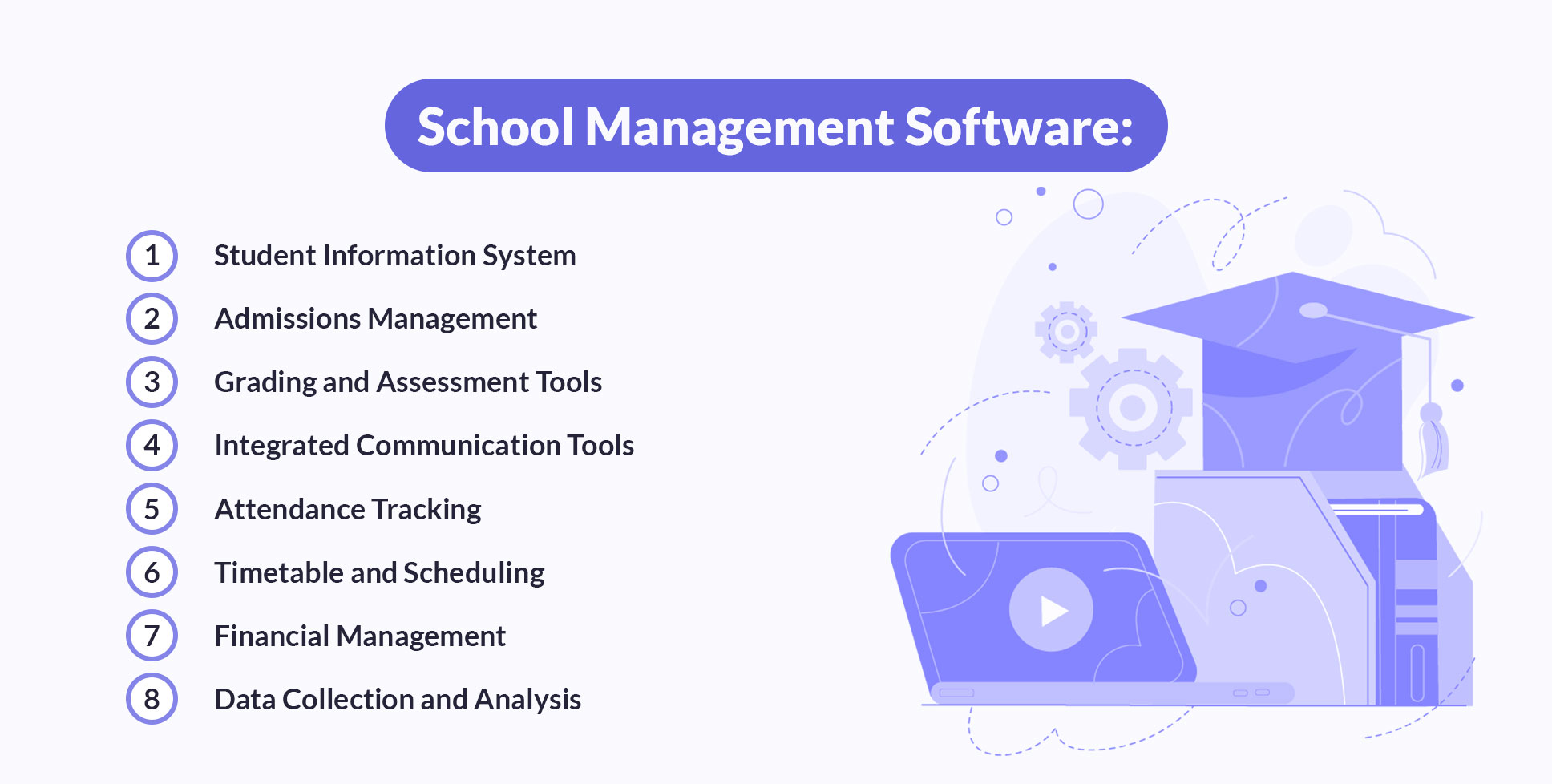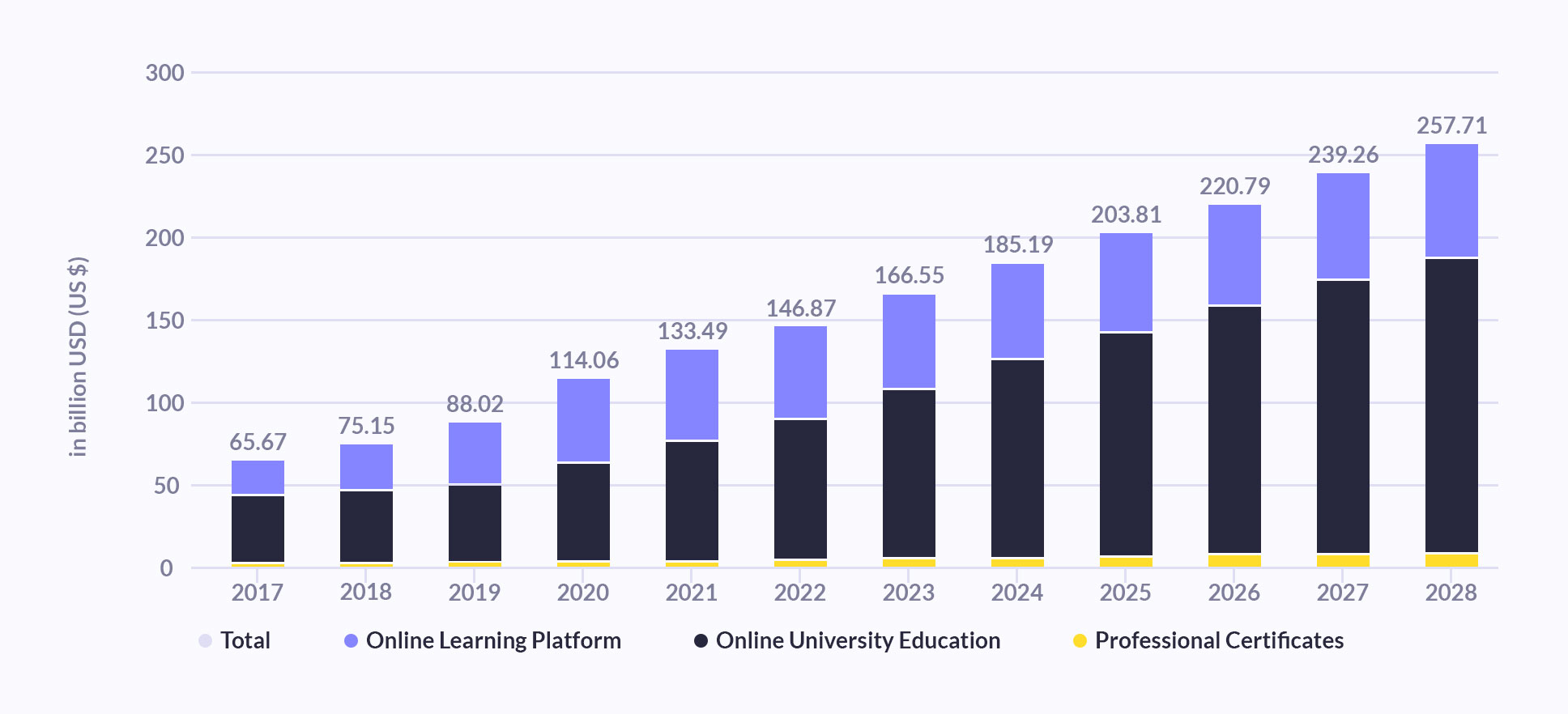Which school management software features are must-haves for educational institutions? School administration is usually overwhelmed by diverse tasks at school. This happens when schools have limited resources and more expectations on what they should deliver. There are finances, enrollment rates, schedules, the inevitable grades, and parental access. This is where school management software comes to the rescue. The global market for this software will reach a whopping $11.95 billion by 2027, all due to the massive adoption of school management systems in the cloud.
With appropriate tools, a school can make complex administrative processes, data collection, and storage more streamlined, accessible, and secure from cybercriminals. Read to learn the eight stunning features you should look for in your institution’s school management software solution.
8 key features of efficient school management software

Efficient school management software can enhance your administrative processes and school operations. It makes the experience better for everyone involved with your school. You can centralize the data hub to give school administration, teachers, students, and parents easy access.
Most school management systems contain elements of learning management systems. Schools can use them to track student progress, attendance, academics, etc. They also offer analytics capabilities, which assist educators in developing suitable solutions to enhance results in early learner analysis. Cloud-based software allows for high scalability while saving money.
1. Student information system
A student information system is the most important feature of school management software applications. It’s a centralized student data hub that provides easy access to all information about the student.
The information stored on these online portals includes:
Personal information (name, address, date of birth, parent and student data)
Medical records and emergency contacts
Schedules and extracurricular activities
Class attendance records
Grades and transcripts
Academic standings and achievements
Disciplinary actions
For instance, in Texas, a school district adopted an SIS that provided real-time information on student attendance, performance, and discipline records. This system significantly reduces the time-consuming paperwork and serves as a bridge between parents and teachers, enabling parents to track their child’s progress and act if necessary.
Having role-based access to this student information management system ensures that the data for every student is correct, up-to-date, and secure. Not only does the system enable school management to access key information promptly, but it also eases student/parent access in real time.


Thank you for Subscription!
2. Admissions management
The admissions process is very complex. Admissions management is one of the key features of a school management system most favored by any administrator. With online registration, the system captures the data on applications, enrollments, and billing and passes it into the central information management system for storage and retrieval.
You can also gather the following information through school administration software:
birth certificates
transcripts
medical information
contact information
application status
For instance, some private schools deploy an admissions management system with an automated enrollment process. The software helps free up time by cutting paperwork, facilitating faster application processing, and enabling parents to submit forms and track application status online. Consequently, the proportion of manual errors decreased by around 40% while the enrollment period was shortened at the school.
When a student is approved, you can quickly draft up enrollment contracts. Of course, students can also sign the forms online so administrators can get them back instantly. Finally, you can move students through and assign them to their appropriate classes at the beginning of the school year.
3. Grading and assessment tools
Most schools today embrace online learning, exam management, and test administration. So, grading and assessment tools are essential pieces of the modern education process. These tools allow teachers and parents to keep track of student performance. Also, this feature lets students and parents access test scores and report cards.
Record keeping, in the form of grade books and student records, is entirely flexible to suit your school’s requirements. The teachers can provide specific conditions for grading, and the best school management system can also calculate the GPA, which can be used directly in the student’s transcripts. These transcripts contain essential information, including courses completed, grades, and academic journeys in general.
Furthermore, one can use high-level parameters and reporting options in grading instruments so that the teacher can discern patterns and tendencies in learning success. For instance, if a student is experiencing difficulties performing well in particular lessons, the system may provide the necessary information to help the school and the parents. This makes it easier to implement early interventions and develop an individual education plan for the learners.
4. Integrated communication tools
Integrated tools for internal communication are essential for school management. Texting, notifications, and online portals ensure the timely exchange of information between teachers, administrators, students, and parents. This improves student engagement with the school and allows parents to participate actively in their child’s education.
Key features of the school management system include:
Student portal repository. It allows students to access assignments, grades, and updates, fostering a sense of responsibility.
Parent monitoring. This system enables parents to monitor their children’s attendance, deficiencies, and performance reports and provides communication interfaces with tutors.
Access to school activities. Parents can also view school activities' details, such as events, holidays, or meetings.
Instant communication. Information is instantly available through messaging apps like WhatsApp or other applications, ensuring everyone is well-informed.
Personalized media messaging. The system allows for the personalization of reminder messages, facilitating the easy issuance of critical feedback.
Video updates. Teachers can also use video to send updates or conduct lessons, making learning more effective and engaging.
5. Attendance tracking
Instant access to attendance reports simplifies tracking within the student management system. For teachers, it can be as simple as checking a box, and for parents, they can keep track of the student progress throughout the school year.
One of the benefits of attendance tracking is that it can reveal tendencies. This allows teachers and administrators to examine attendance records to determine if there are any unusual patterns or extensions. Additionally, the National Charter School Center received many complaints from teachers about students missing school, particularly after long weekends. As a result, the center resolved to make assignments and resources available online to address this issue.
Moreover, if a class or teacher consistently has low turnout or less-than-average attendance, the system can identify the problem. It might be teaching style, material, or anything else. However, if detected early, these problems can be solved, and they will improve general student e-learning and decrease truancy.
6. Timetable and scheduling
Timetable and class scheduling are primary features of the school management system. These tools ease subject distribution and allow administrators to create detailed instructor timetables. Furthermore, having a central hub for all class schedules and events can prevent scheduling overlaps. Without these conflicts, students can participate in all their assigned classes.
Another advantage is that every day’s timetable is available anywhere via the best school management application, which is convenient for children and teachers. These filters make it easy to manage some needs. For instance, users can filter the schedules by students, teachers, or class types.
Some advanced features include quickly reorganizing schedules whenever there are changes, such as absent teachers or room availability. This way, everyone is updated in real time.
For schools offering many co-curricular activities, links to the event management features enable directors to manage learning and non-learning events from a common platform. This cuts conflict instances and allows students or teachers to make early arrangements. Such scheduling systems include resource management features that optimize the use of classrooms and equipment, effectively minimizing time losses.

More from our blog
How VR transforms education institutions
Learn more about how virtual reality in education changes the process. Implementation minimized challenges and tangible advantages.
Read more7. Financial management
Managing finances via an app can make enrollment and fee collection straightforward for your school. Efficient school management systems streamline all or most of their administrative tasks. Managing and collecting student fees and creating invoices and receipts are a breeze with a well-organized school administration software application. So, all the billing information, schedules, and fee management are just a few clicks away.
School systems also provide options to school administrators regarding sending out reminders and alerts to students and parents about the new fees that are due. Schools also often facilitate and monitor online payments to ensure this is fast for parents and the school staff. Payments are made and tracked in real time, which saves a lot of time compared to following up on due amounts.
An example of such a school is The International School of Kuala Lumpur, which has features, including implementing automatic fee collection. This has enabled parents to pay fees via their mobile phones, thus making the processes easier and improving the school's cash flow.
8. Data collection and analysis
The final aspect of the best school management software is the data collection and analysis function. The school management app will collect and store valuable information that you can use to elevate your school above competitors.
For one, you can track school records and the number of admissions to identify trends, patterns, and student demographics. Then, you can tweak your marketing and outreach efforts. You can also keep track of student attendance and performance. With this, it’s easy to pinpoint the areas where you need to send more resources. You can promote your students' success stories if they excel in some subjects or activities.
Furthermore, data indicating a student's proficiency in certain subjects or extracurricular activities can be useful. This information can highlight achievements and enhance the school's image. Schools like Greenwich High School use such insights to show their success stories and try to attract many enrollments.
Those are the main features of school administration systems that ensure effortless operations. If you want additional features from your software, you can look into library management, inventory, transportation management, etc. Our school management software professionals at Geniusee can help you grasp any innovative school management solution. Take the plunge, and you will automate tasks, improve efficiency and security, and reduce administration costs.
Security and сompliance focus
Since schools store and manipulate information about students and other aspects of institutions on digital systems, the security of this information is crucial. Thus, adequate protection of every educational institution and compliance with legislation requirements are urgent goals in the modern threat environment. Besides, protecting confidentiality, integrity, and availability of resources is the key to avoiding security breaches and complying with the necessary regulations, such as FERPA and GDPR.
Key focus areas for security and compliance in school management systems include:
Data encryption: Ensure all data collected from and about students is encrypted in motion and at rest.
Multi-Factor Authentication (MFA): For sensitive information and systems, use at least two-factor authentication (passwords, fingerprints, tokens).
Regular security audits: A regular audit helps to define which points can be weak spots and should be enhanced before an opponent tries to use that opportunity.
Compliance with regulations: Follow some field-specific laws, including FERPA and GDPR, that apply to the collection, storage, and use of student data.
Role-Based Access Control (RBAC): Applying restricted user profile access to prevent unauthorized users from having the sole capability of viewing or altering students' information.
Data backup and recovery: Continuously archive vital data and have contingency measures in case the computer systems get compromised due to a vulnerability.
User training: Screening staff and administrators and making them understand the role of data protection, how phishing attacks occur, and how to manage sensitive data.
The future of online school management
Educational institutions that want to outperform the competition and provide the best for their students should embrace cloud-based school management systems. The need for EdTech software solutions follows the growth trends of the online learning market, which will reach $325 billion in revenue by 2025.

For instance, whereas AI tutoring can assist a student in real time according to their learning type and pace, grading saves academic personnel time so they can spend more time with learners. Other examples include the use of AI in scheduling to develop practical teaching timetables for classes throughout a given interval, maximizing the use of time by tutors, and minimizing the complexities created by course schedules.
However, implementing such high technologies is difficult, especially when combining them. Data preservation is one of the most crucial issues educational institutions still face, as students’ information should be safeguarded. We also think that this kind of implementation should be followed up by ensuring that teachers and school principals know how to maximize the use of these tools. On the bright side, it is now possible to protect such data through the recent innovations in the cybersecurity solutions available in the market.
However, advanced techniques for developing modern school management systems have allowed users of any level to create and implement these technologies. That is why schools such as The American School in Dubai already use cloud-based AI solutions to automate practically all aspects of work. You can track attendance and communicate with parents to see what education will look like.
Conclusion
In showing the eight features discussed above, it becomes possible to understand how school management software can streamline several administrative functions, provide efficient communication, and positively change learning achievement. Through developments such as student information systems, admissions management, grading and assessment, and attendance tracking, the institutions benefit from better organizational structures, informed decision-making, and overall enhanced experience for students, teachers, and parents.
While new software and applications are being adopted in educational institutions, schools save time and money and adapt to future cloud learning, AI, and intelligent systems. Whether your priority is to enhance your school's efficiency or try your best to help you organize upgraded fashionable solutions, having effective school management software can make a difference.
The time is now to improve your school’s management. Feel free to contact us to learn how our school management software development can simplify your operations, secure your data, and contribute to creating the best learning environment!





















